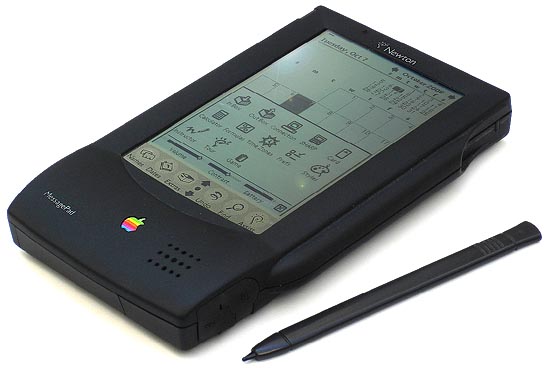Think back. It’s 1992. You don’t have a cell phone, unless you’re rich. If you do, it’s a phone. It makes calls. That’s it. There’s no internet. Mobile computing means carrying around a 20 pound suitcase with a floppy disk drive.
And then, you see this.

It’s about the size of a paperback book. It costs $1,000, which is about two months rent on a nice 2-bedroom apartment. And it makes big promises. Not just an electronic organizer — those have been around for 10 years. You can write letters, use a spreadsheet, even paint. And you can do it as easily as writing in a notebook. It was Apple’s first mobile device, the Newton.
Take a look at this video from its launch, showing the Newton in action:
And it was a flop.
It was a flop because for $1,000 it didn’t work as well as a $3 pad of paper. It couldn’t read your handwriting very well and it was … … … slow. Very slow. Even by the standards of the day. Newtons kept improving but they never got past the initial bad press handed to them by a popular comic strip.
Back in those days, when we didn’t have social media or memes, people read the newspaper. And they looked at the comics for easily-digestible bits of folk wisdom. One of the most popular comic strips of the day was Doonesbury, and when this strip was published in 1993, Newtons began their death spiral.

Sadly, the strip accurately showed the big problem with Newtons. Input was practically impossible. Without the ability to input information, the device was essentially useless.
Gone, but not forgotten
Newton was a failure, but it spawned generations of success. The company that wrote the handwriting recognition realized how poorly they’d done. They resolved to create their own device that solved all of Newton’s problems. It would be smaller, cheaper, and use a modified text recognition system that actually worked. Their company, Palm, owned the mobile space in the mid-2000s. Their Palm VII was the first really viable internet-connected mobile device and the Treo, which licensed Palm’s software, was a game-changing smartphone, possibly the first gamechanging smartphone.
In the meantime, Newton’s failure was legendary within Apple. It was one of many missteps made during that time period when Steve Jobs had left the company. When Mr. Jobs rejoined Apple, he saw mobile as the future. This time, he declared, mobile devices would be intuitive, they would be sleek, and they would work. I think we all know how that worked out.
27 years from now…
Sure we laugh at the 90s-tastic plastic cladding, the low-fi monochrome image and the lack of connectivity. I had the opportunity to play with a Newton not long ago and it’s really as bad as everyone says it was. But it’s a reminder how far we’ve come in almost 30 years. The pace of change increases every year, so it’s impossible to imagine what we’ll see in 27 more years. It will make today’s cell phones look like this Newton, or worse.




